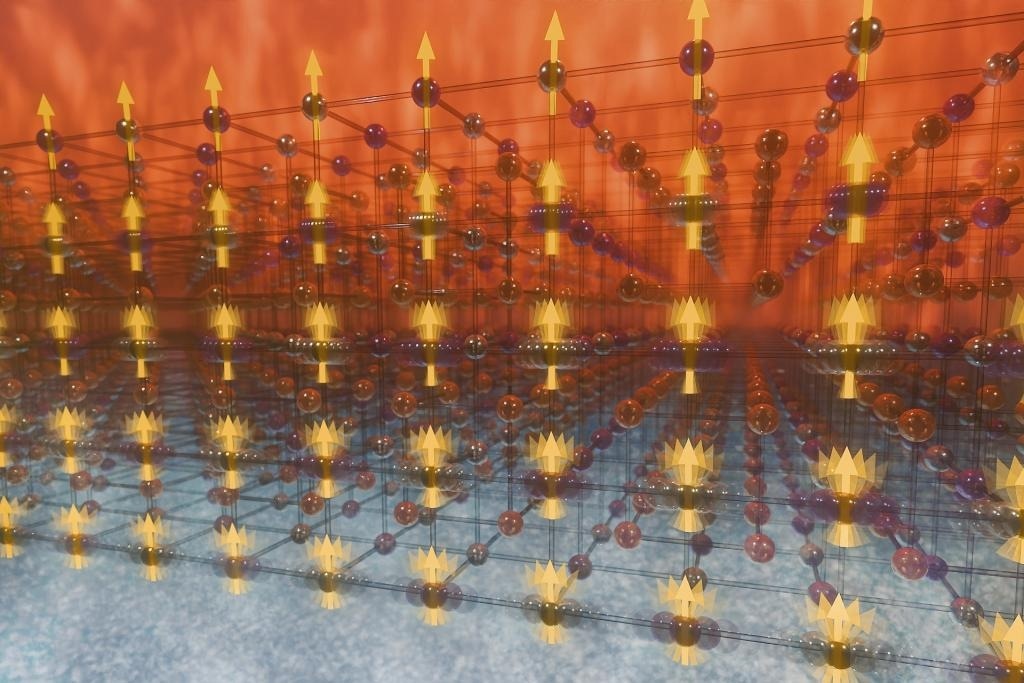A team of scientists at Oak Ridge National Laboratory, part of the Department of Energy, has closed a knowledge gap in atomic-scale heat motion. With this new knowledge, materials science may be able to improve solid-state cooling, a developing technique. This research was published in the journal Science Advances.
 Strong coupling between localized atomic vibrations and spin fluctuations increases the absorption and release of heat, shown from the bottom to the top, in a magnetic shape-memory alloy, improving its capacity for solid-state cooling. Image Credit: Phoenix Pleasant/ Oak Ridge National Laboratory, US Dept. of Energy
Strong coupling between localized atomic vibrations and spin fluctuations increases the absorption and release of heat, shown from the bottom to the top, in a magnetic shape-memory alloy, improving its capacity for solid-state cooling. Image Credit: Phoenix Pleasant/ Oak Ridge National Laboratory, US Dept. of Energy
Solid-state cooling is an environmentally benign invention that has the potential to efficiently cool a wide range of everyday items, including electronics, cars, and food, without the need for moving components or the usual liquids and gases used in refrigeration. Lightweight, silent, and compact technology makes precise temperature management possible.
A deeper understanding of material upgrades is necessary, even though the development of higher-quality devices and the discovery of improved materials are already contributing to the expansion of the new cooling technique. Utilizing an array of neutron-scattering devices, the research group investigated a substance that is thought to be the best option for solid-state cooling at the atomic level.
The substance, a magnetic shape-memory alloy composed of nickel, cobalt, manganese, and indium, can undergo deformation and regain its original form through a phase transition that can be induced by either increasing temperature or applying a magnetic field.
The material experiences a magnetic and structural phase transition in the presence of a magnetic field, which causes it to absorb and release heat, a process referred to as the magnetocaloric effect.
This phenomenon is utilized in solid-state cooling applications to produce refrigeration. The material's proximity to disordered states, known as ferroic glassy states, is one of its important properties since it offers a means of improving the material's capacity to store and release heat.
Magnons, sometimes called spin waves, and phonons, or vibrations, pair in small areas scattered throughout the material's chaotic arrangement of atoms to produce a synchronized dance. The behavior patterns in these tiny areas, which the team named localized hybrid magnon-phonon modes in their study report, have significant effects on the material's thermal properties, the researchers discovered.
The scientists discovered that the modes dramatically displacing or altering the phonons when a magnetic field is present alters the phase stability of the material. These modifications may cause fundamental changes in the material's properties and behavior, which can then be adjusted and customized.
Neutron scattering shows that the cooling capacity of the magnetic shape-memory alloy is tripled by the heat contained within these local magnon-phonon hybrid modes that form because of the disorder in the system. This finding reveals a path to make better materials for solid-state cooling applications for societal needs.
Michael Manley, Study Lead and Senior Researcher, Neutron and X-Ray Scattering Group, Oak Ridge National Laboratory
The magnetic shape-memory alloy under study is in a phase when disordered conditions known as strain glass and spin glass have almost formed. These are not the same as the common glass used in windows and other places but rather unusual phases of matter that lack order.
Instead of pointing in the same direction, the magnetic moments, or small magnets, connected to the atoms in the spin glass phase are orientated randomly. In contrast, the atom lattice is stressed in an uneven and disorganized manner at the nanoscale level in the strain glass phase.
The spin glass and strain glass result from opposing interactions or limitations that keep the material from reaching a stable ordered state; they are known as frustrated states in a material.
As the material approaches this frustrated state, the amount of heat being stored increases. Long- and short-range interactions manifest as localized vibrations and spin waves, which means they’re getting trapped in small regions. This is important because these extra localized vibrational states store heat. Changing the magnetic field triggers another phase transition in which this heat is released.
Michael Manley, Study Lead and Senior Researcher, Neutron and X-Ray Scattering Group, Oak Ridge National Laboratory
Managing the magnetic shape-memory alloy's properties to enable its usage as a heat sponge could be one approach to enabling effective solid-state cooling without the requirement for conventional refrigerants or mechanical parts.
The research was funded by DOE’s Office of Science Materials Sciences and Engineering Division. A portion of the neutron scattering work for this research was performed at the High Flux Isotope Reactor and the Spallation Neutron Source, DOE Office of Science user facilities at ORNL. The National Institute of Standards and Technology of the Department of Commerce also provided neutron research facilities.
Journal Reference:
Manley, M. E., et al. (2024) Hybrid magnon-phonon localization enhances function near ferroic glassy states. Science Advances. doi.org/10.1126/sciadv.adn2840.